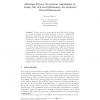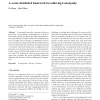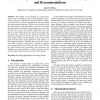1701 search results - page 3 / 341 » Providing k-anonymity in data mining |
KDD
2007
ACM
14 years 7 months ago
2007
ACM
Abstract. As more and more person-specific data like health information becomes available, increasing attention is paid to confidentiality and privacy protection. One proposed mode...
VLDB
2008
ACM
14 years 7 months ago
2008
ACM
In this paper we present extended definitions of k-anonymity and use them to prove that a given data mining model does not violate the k-anonymity of the individuals represented in...
VLDB
2006
ACM
14 years 7 months ago
2006
ACM
k-anonymity provides a measure of privacy protection by preventing re-identification of data to fewer than a group of k data items. While algorithms exist for producing k-anonymous...
DMIN
2009
13 years 5 months ago
2009
Abstract - Data mining is used regularly in a variety of industries and is continuing to gain in both popularity and acceptance. However, applying data mining methods to complex re...
CIKM
2009
Springer
14 years 2 months ago
2009
Springer
Data generalization is widely used to protect identities and prevent inference of sensitive information during the public release of microdata. The k-anonymity model has been exte...



